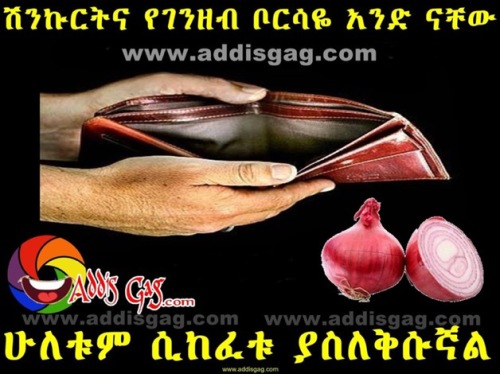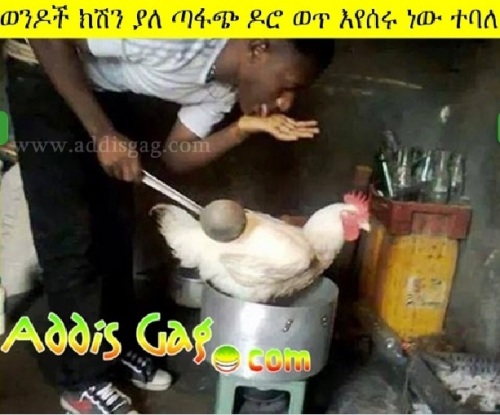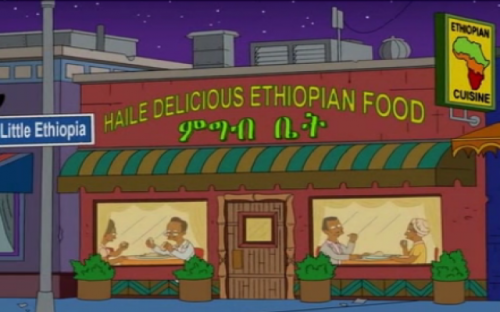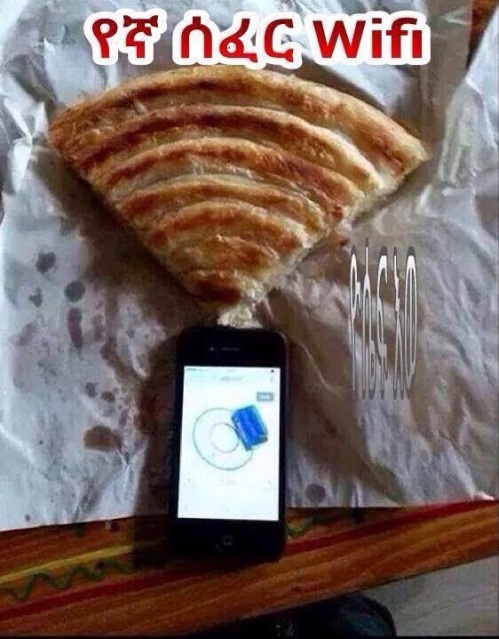WHAT’S SO FUNNY about Ethiopian food?
A lot, it turns out.
Here’s some visual food-flavored humor from a few Ethiopian websites, along with translations and explanations as necessary.
Most of the images below appear on the website amharicjokes.net. I haven’t taken the images from the site but rather have embedded them below on my site. If you click on any of the images, you can visit the original site. A few images come from other sites, and once again, clicking on the image takes you to the site.
This joke puns on Gouder, a well-known brand of wine made in Ethiopia and sold both domestically and abroad. It’s a semi-dry wine, and you’ll find it in many Ethiopian restaurants in the United States.
Here’s a gag that combines food and technology: The two Amharic letters at the end of the first word are pronounced “jera” – as in injera. The joke puns on the slogan “Intel Inside” used by the company that makes the famous computer processors.
Each year, during the Lenten season, Ethiopian Christians fast: That means eating no food before midday and then only vegetarian dishes. But for dinner on Fasika – that is, Easter – you can eat meat again, and that means anything with four legs faces a dire fate (or two legs, if doro wot is on the menu). These two images play on the passion with which Ethiopians return to eating meat when the Lenten season ends, as well as a custom in Madrid to attend bullfights on Easter Sunday.
Here’s a gag for the age of social media. It seems women spend so much time on Facebook that they’ve forgotten how to make proper injera. It may be the 21st Century, but sexism is still with us.
This one is so obscure that an Ethiopian-American friend had to ask friends in Ethiopia to explain it – and they all concluded that it’s not very funny. The man is eating tere siga (raw meat), an Ethiopian favorite, and he loves it so much that he doesn’t want to wash it down with mere Ambo, a brand of Ethiopian bottled spring water. So he’s using amir, which is – glue! This way, the food will stick to his stomach and he can remember the pleasure of eating it.
Here’s a strange one. It seems someone doesn’t have room for ice cream in the freezer because there’s already so much siga (beef) and berbere (red pepper powder). If you put siga and berbere together, you have siga wot, a basic beef stew. So I suppose this cartoon reminds us of how much Ethiopians love beef, especially after not eating any during Lent.
This image comes from a humor site called Addis Gag. The question: What does a wallet and an onion have in common? The answer: They both make you cry when you open them.
Doro wot may be the national dish of Ethiopia, but the country’s chickens don’t much care for it: The Amharic letters at the top of this cartoon, when pronounced, say “horror film.”
From Addis Gag comes this riff on men in the kitchen. “Rumor has it that some men have been making some good doro wot,” the writing says. And yet, this fellow seems like he’s about to make a mess of things. I can’t speak for all men, but my doro wot is betam teru.
This is a weird one from Addis Gag. Apparently, there’s an old saying in Ethiopia: If you’re broke, eat butter. But here, someone is substituting Vaseline for butter because (it seems) the price of butter is too high. My thanks to my friend Menkir Tamrat, who makes Yamatt Tej, for help in translating these last two. In fact, of this one, he observes: “Probably won’t make much sense [in the U.S.] where Vaseline costs more than butter.”

Not too much explanation needed here: The quip plays on the famous slogan promoting tourism to Las Vegas. And no off-site link for this one: It’s mine.
This cartoon, posted on the well-known comedy website Funny or Die, offers dark humor: Much of Ethiopia faces drought and starvation, so the world often thinks that’s all Ethiopia is. In fact, it has a unique and ancient cuisine – that only some of the population can afford to eat.
This cartoon is a joke on Americans: In Ethiopia, where generosity reigns at the dinner table, everyone wants to pick up the tab. In America, when the bill arrives, everyone looks away. Habesha is the modern form of a 2,000-year-old word used today to refer to Ethiopians and Eritreans. It’s also the word that transformed, centuries ago, into Abyssinia, the name by which Europeans and other foreigners called Ethiopia for centuries (although Ethiopia never called itself by that name).
And speaking of funny Americans: A few seasons ago on The Simpsons, Marge and the kids found themselves in an Ethiopian restaurant – and they enjoyed it. Later, though, when they took some leftovers home to Homer, he turned up his nose. But it looks like he’s had a change of heart and even plans to butcher his own chicken to prepare doro wot for gena (Christmas). (Watch the full video of the Simpsons’ visit to an Ethiopian restaurant.)
Here are two scenes from the Simpsons episode where Marge, Bart and Lisa find themselves stranded in Little Ethiopia after their car breaks down. They decide to try this exotic-looking food – and they end up loving it. In the top image, we see a restaurant called Haile Delicious, a play on Emperor Haile Selassie of Ethiopia (haile means power, selassie means trinity). Inside the restaurant, a group of pretentious foodies are shocked to see that the Simpsons have been served a huge tray of “zilzil minchet alicha wot” from the “untranslated menu.” So they crash the table, and everyone engages in gursha, the act of placing food into the mouth of someone else at the table. The name of this elaborate meal is a sort of double oxymoron. Zilzil is strips of meat, and minchet is ground meat; an alicha is a mildly spiced stew, and a wot is a spicy stew. Or perhaps the name just means that you get all four of these types of dishes on your gebeta. Whatever the case, whoever wrote and animated the episode clearly did some homework: The Amharic on the signs of the restaurants in Little Ethiopia is excellent. And who knew that Springfield even had a Little Ethiopia? Too bad it took them 23 seasons to find it.
Internet services in Ethiopian can be spotty, and sometimes it’s hard to get through to a website that ends with a dot-et address. The words at the top here say “Our Neighborhood Wifi,” and it seems that a slice of ambasha – a traditional Ethiopian bread – serves as an antenna.
Finally, this cartoon simply says melkam addis amet – that is, happy new year – as a family sits down to celebrate with a meal. The Ethiopian new year takes place every Sept. 11 on the Western (Gregorian) calendar, which is Meskerem 1, the first day of the first month of the Ethiopian calendar, which is seven years behind ours on Ethiopian new year’s day. The second line of writing above tells us the year: Those are the Ethiopic numbers for 20, 100 and 6 – that is, 20 times 100, plus six, or the year 2006. That would be 2013 on the Western calendar. The two letters after the year are “a.m.,” which stands for amata mehrat, or “year of mercy,” the Amharic equivalent of A.D.
Harry Kloman
University of Pittsburgh




















Leave a comment